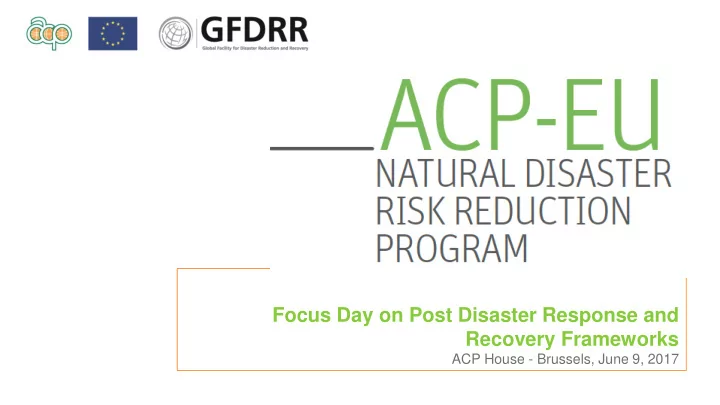

Focus Day on Post Disaster Response and Recovery Frameworks ACP House - Brussels, June 9, 2017
Session 2 : ACP-EU NDRR Program sharing country experiences and lessons learned TONGA Rosamond Bing Chief Executive Officer Ministry of Lands and Natural Resources ACP House - Brussels, June 9, 2017
TONGA General Context 100,745 (2016 Census : Preliminary Results) 70% urban population 170 islands (36 inhabited) – 5 island groups with total land area of 747km2 Country Risk Profile: Natural Hazards Climate Change induced – El Nino, increase in temperature, sea level rise and tropical cyclones Geological hazards – earthquake and tsunami and volcanic eruptions Major Risks Buildings Cash crops Infrastructure
Major events the last 20 years 2002 – Tropical Cyclone Waqa 2009 – Niuatoputapu Earthquake and Tsunami 2014 – Tropical Cyclone Ian
DRM institutional organization Institutions in charge of DRM and CCA MEIDECC – National Emergency Management Office and Climate Change Division DRM National Platform ? MEIDECC supporting the National Emergency Management Committee, which meets as necessary DRM National Strategy in place ? JNAP-CCA/DRM 2010-2015. JNAP is currently being reviewed and is to be aligned with Sendai Framework Are DRR and CCA part of the National Development Strategy ? TSDF 2015-2025 : National Outcome F (Land, Environment and Climate Change) – inclusive, sustainable and effective land administration, environment management and resilience to climate change and risk Existing legislation, building codes etc.. Emergency Management Act 2007, Environment Management Act 2010 and Building Control and Standards Act 2002
Tonga Cyclone Ian Reconstruction and Climate Resilience Project BRIEF HISTORY OF THE EVENT Severe Tropical Cyclone Ian - the most powerful storm ever recorded in Tongan waters - made landfall on 11 January 2014. The Category 5 system brought winds of over 200km/hour and hit the island groups of Vava’u and Ha’apai prompting the Prime Minister to declare a state of emergency. GOVERNMENTAL RESPONSE AND PROCESS TC Ian first appeared as a tropical depression between Fiji and Tonga on 6 January, and took five days to develop into a Category 5 system. The slow movement of the system gave the Government time to activate its National Emergency Management Committee to coordinate district and village preparedness networks, and issue warnings over national radio. Around 50 per cent of the estimated 1,130 buildings on Ha'apai’s affected islands were completely destroyed, with over 2,300 people forced into more than 50 shelters.
Tonga Cyclone Ian Reconstruction and Climate Resilience Project DEVELOPMENT OBJECTIVES OF THE PROJECT o Restore housing, community facilities, and basic services to the affected population of Ha'apai; and o Strengthen the country's resilience to natural disasters. PROJECT COMPONENTS o Repair and reconstruction of housing and key community facilities o Technical assistance and training for enhanced disaster and climate resilience o Project implementation support
Recovery Phase – Recovery Strategy The overall goal of the Post-Ian Housing Recovery and Reconstruction Policy is to ensure that households directly affected by TC Ian are living in safe houses in safe locations, acceptable to the family, and that contractor-built houses for the most vulnerable families are completed in a timely manner. • Ensure households are in safe shelter while awaiting permanent housing solutions. • Assist households to replace houses damaged beyond repair. • Assist households to repair and retrofit other damaged houses. • Resolve the risks of those situated in unsafe sites or with insecure tenure, as a last resort, through relocation. • Ensure that households receiving assistance have access to public and social services.
Assessment follow up Recovery and Leverage Technical assistance to be mobilized by the project to collaborate with Government and stakeholders on the formulation of the Lessons Learned with a view to informing the development of a National Disaster Recovery and Reconstruction Framework Achievements to date Reconstruction and retrofitting in accordance with building code and standards Housing recovery and reconstruction policy Land consents completed Capacity building and up-skilling of building inspectors, GIS and affected communities Strengthened coordination through the Task Force Group mechanism with autonomy and authority to make decisions
Lessons learned and challenges The ACP-EU NDRR Program value added Formulation and implementation of the Housing Recovery and Reconstruction Policy through technical assistance (policy consultant) Pacific Catastrophe Risk Assessment and Financial Initiative (PCRAFI) assessment through technical expertise Post Disaster Beneficiary Assessment – second assessment was conducted to validate the initial assessment through formulation of the assessment questionnaire The ACP- EU NDRR Program’s contribution to the Project was instrumental in project design/preparation, securing financing and its successful implementation. Lessons learned and main challenges The mobilization of financing is contingent on sound risk assessment and robust policies and plans Assessments must be conducted in a timely but comprehensive manner
Recommend
More recommend